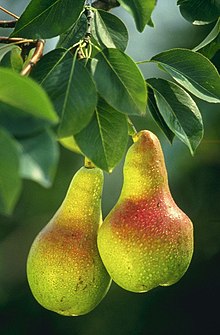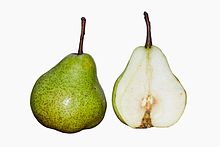Pyrus
| Pears | |
|---|---|
 |
|
| European Pear branch with two pears | |
 |
|
| Pear fruit cross section | |
| Scientific classification | |
| Kingdom: | Plantae |
| (unranked): | Angiosperms |
| (unranked): | Eudicots |
| (unranked): | Rosids |
| Order: | Rosales |
| Family: | Rosaceae |
| Subfamily: | Amygdaloideae |
| Tribe: | Maleae |
| Subtribe: | Malinae |
| Genus: |
Pyrus L. |
| Species | |
|
About 30 species; see text. |
|
| Nutritional value per 100 g (3.5 oz) | |
|---|---|
| Energy | 239 kJ (57 kcal) |
|
15.23 g
|
|
| Sugars | 9.75 g |
| Dietary fiber | 3.1 g |
|
0.14 g
|
|
|
0.36 g
|
|
| Vitamins | |
| Thiamine (B1) |
(1%)
0.012 mg |
| Riboflavin (B2) |
(2%)
0.026 mg |
| Niacin (B3) |
(1%)
0.161 mg |
| Pantothenic acid (B5) |
(1%)
0.049 mg |
| Vitamin B6 |
(2%)
0.029 mg |
| Folate (B9) |
(2%)
7 μg |
| Choline |
(1%)
5.1 mg |
| Vitamin C |
(5%)
4.3 mg |
| Vitamin E |
(1%)
0.12 mg |
| Vitamin K |
(4%)
4.4 μg |
| Minerals | |
| Calcium |
(1%)
9 mg |
| Iron |
(1%)
0.18 mg |
| Magnesium |
(2%)
7 mg |
| Manganese |
(2%)
0.048 mg |
| Phosphorus |
(2%)
12 mg |
| Potassium |
(2%)
116 mg |
| Sodium |
(0%)
1 mg |
| Zinc |
(1%)
0.1 mg |
|
|
|
|
|
| Percentages are roughly approximated using US recommendations for adults. Source: USDA Nutrient Database |
|
About 30 species; see text.
The pear is any of several tree and shrub species of genus Pyrus /ˈpaɪrəs/, in the family Rosaceae.
It is also the name of the pomaceous fruit of the trees. Several species of pear are valued for their edible fruit, while others are cultivated as ornamental trees.
The word “pear” is probably from Germanic pera as a loanword of Vulgar Latin pira, the plural of pirum, akin to Greek apios (from Mycenaean ápisos), of Semitic origin ("pirâ"), meaning "fruit". The term "pyriform" is used to describe something pear-shaped.
The pear is native to coastal and mildly temperate regions of the Old World, from western Europe and north Africa east right across Asia. It is a medium-sized tree, reaching 10–17 metres (33–56 ft) tall, often with a tall, narrow crown; a few species are shrubby.
The leaves are alternately arranged, simple, 2–12 centimetres (0.79–4.72 in) long, glossy green on some species, densely silvery-hairy in some others; leaf shape varies from broad oval to narrow lanceolate. Most pears are deciduous, but one or two species in southeast Asia are evergreen. Most are cold-hardy, withstanding temperatures between −25 °C (−13 °F) and −40 °C (−40 °F) in winter, except for the evergreen species, which only tolerate temperatures down to about −15 °C (5 °F).
The flowers are white, rarely tinted yellow or pink, 2–4 centimetres (0.79–1.57 in) diameter, and have five petals. Like that of the related apple, the pear fruit is a pome, in most wild species 1–4 centimetres (0.39–1.57 in) diameter, but in some cultivated forms up to 18 centimetres (7.1 in) long and 8 centimetres (3.1 in) broad; the shape varies in most species from oblate or globose, to the classic pyriform 'pear-shape' of the European pear with an elongated basal portion and a bulbous end.
...
Wikipedia
